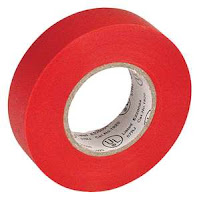 |
| Red Duct Tape: a critical tool in milk quality! |
It's not uncommon for us to frequent area stores to purchase some interesting items to use on our dairy farm. It's definitely fun to watch the eyes of cashiers as I check out large quantities of bleach, rubbing alcohol, and colored duct tape...red duct tape specifically. This past week was like so many others. I was on my way to town with my master list of things we needed at the farm and home. So many errands to run, so little time. So I scurried through the isles of our local Wal-Mart working my way down my list. I'm a huge bargain hunter and coupon user, so I'm always distracted. As I rushed to the check out I greeted my cashier and started unloading my cart. This shopping trip was like so many others, the cashier's eyes got big as she scanned multiple gallons of bleach, bulk bundles of paper towels, several bottles of rubbing alcohol, and then she couldn't hold it in any longer...she scanned in my roll of red duct tape.
"Well, my goodness! This is a "colorful" way to keep someone quiet!", she exclaimed. "Haha! That's not exactly what I had intended for that red duct tape." And then it hit me....a perfect opportunity to have a quick chat with this lovely lady about the importance of producing quality milk on our farm!!!! I love it when these opportunities pop up, and I seldom walk away from a good chance for education...so I proceeded.
"Well, my goodness! This is a "colorful" way to keep someone quiet!", she exclaimed. "Haha! That's not exactly what I had intended for that red duct tape." And then it hit me....a perfect opportunity to have a quick chat with this lovely lady about the importance of producing quality milk on our farm!!!! I love it when these opportunities pop up, and I seldom walk away from a good chance for education...so I proceeded.
 |
| One strip of duct tape on both rear legs helps us recognize a "treated cow" in the parlor, making sure our milk is always perfect! |
"You see, I'm a dairy farmer. And that red duct tape is the perfect tool for marking my cows' legs. When we have a cow that is sick and needs to be treated with antibiotics we automatically place a strip of this red duct tape on each of her rear legs. This allows us to see her quickly, recognize her, and make sure that we milk her separately from the other cows. Antibiotics are not allowed in milk for sale, so we work hard to make sure that our milk is always perfect, and if it's not perfect, we pitch it. If we "accidentally" get antibiotics in our tank, the consequences are very severe...so this red duct tape has a VERY important job on our farm!"
"Wow, I never knew that dairy farmers had to keep antibiotics out of milk. I guess I just assumed it was all mixed together!" she shared with me. How many other consumers shared her thoughts. No one had ever explained to this kind lady how dairy farmers are tested multiple times each pick for antibiotics. Food safety comes first, and we take our responsibilities very seriously. We continued to have a great conversation as the cashier check out the last of my items. That day I left the store having shared with a nice woman, the importance of milk quality and antibiotics on our dairy farm....and that was time well spent!
